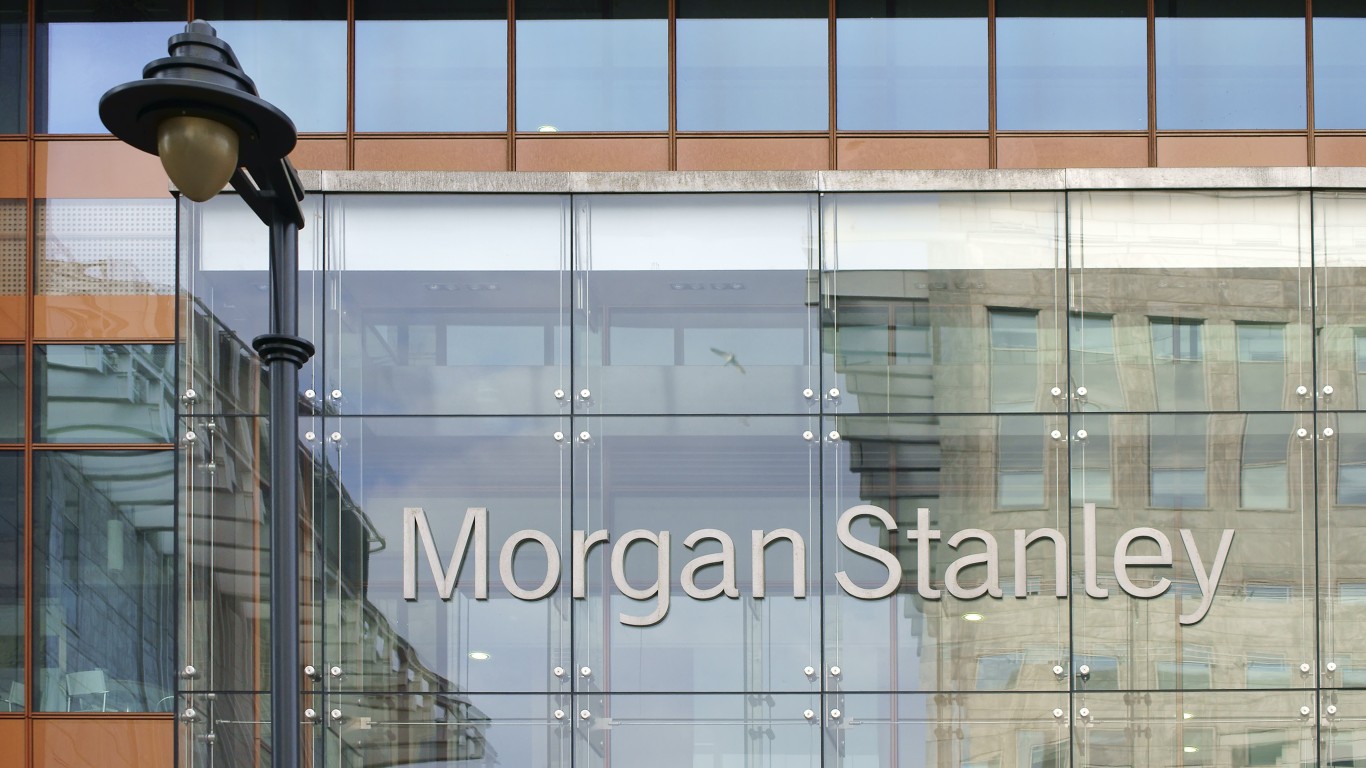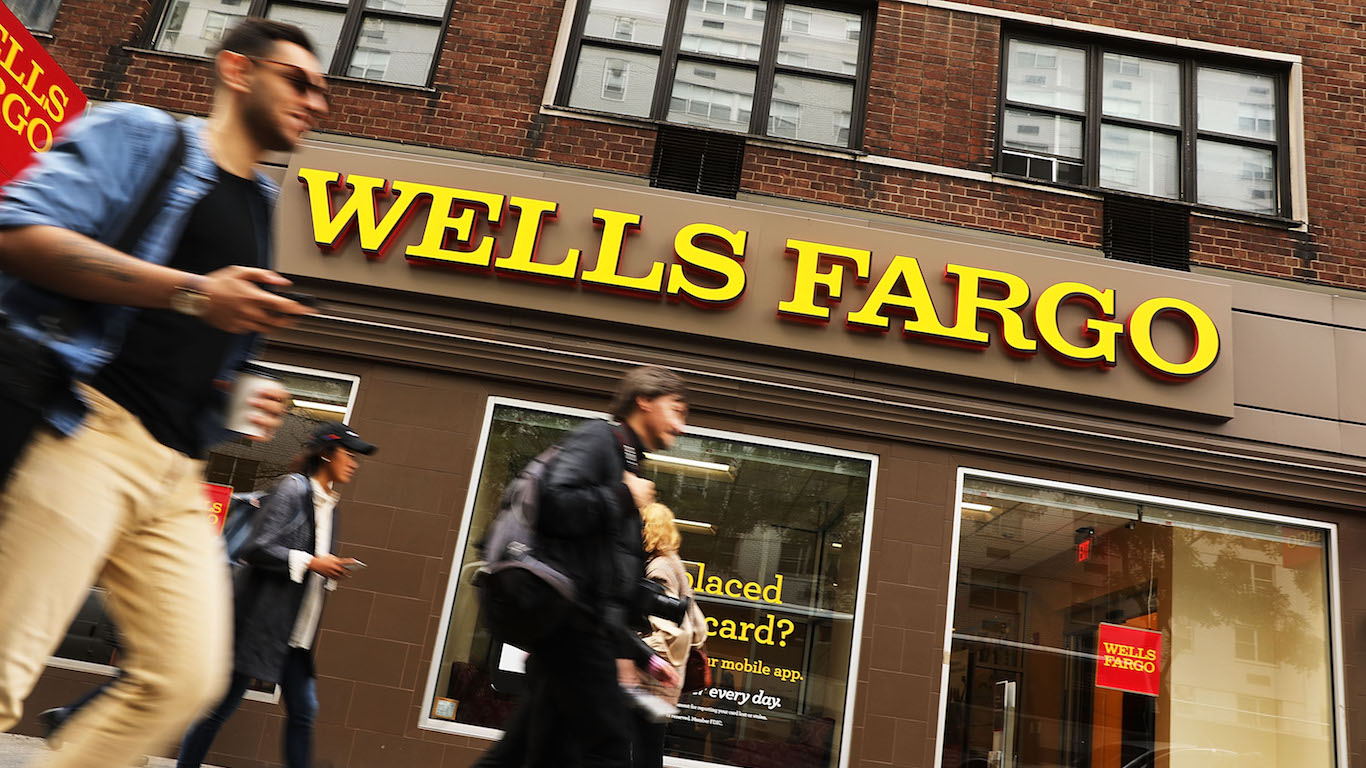
In mid-morning trading on Monday, the Dow Jones industrials were up 0.04% while the S&P 500 was down 0.07% and the Nasdaq 0.22% lower.
Before markets opened on Monday, M&T Bank posted better-than-expected profits thanks to higher interest rates. Net interest income doubled to $1.83 billion year over year, even though deposits dropped by 3%. The stock traded up about 1.4% Monday morning.
[in-text-ad]
Charles Schwab beat the consensus earnings per share (EPS) estimate but missed slightly on revenue. Shares traded up about 3.3%.
State Street failed to meet or beat EPS and revenue expectations. Net interest income rose about 50% year over year, but net income overall was down more than 9%. The stock hammered Monday morning, down 12.5%.
Bank of America, BNY Mellon and Goldman Sachs are scheduled to report first-quarter earnings before U.S. markets open on Tuesday, along with Ericsson, Johnson & Johnson and Lockheed Martin. later that day, look for reports from Netflix, United Airlines and Western Alliance Bancorp.
Here is a look at four companies set to report first-quarter results first thing Wednesday morning.
Abbott Labs
Medical device and generic drug maker Abbott Laboratories (NYSE: ABT) has dropped more than 11% from its stock price over the past 12 months. The stock hit a 52-week low in late October and has bounced to a 10% gain since.
Abbott stock was up about 20% from its low in late January before the company revealed that the U.S. Federal Trade Commission had filed a civil investigative demand for information related to issues with the company’s baby formula. The company also faces a criminal investigation by the Department of Justice and numerous civil lawsuits related to its infant formula.
Among 24 analysts covering the stock, 18 have a Buy or Strong Buy rating and five more rate it at Hold. The median price target is $118.00, and with shares currently around $104.70, the upside potential is 12.7%. At the high target of $136.00, the upside potential increases to 29.9%.
First-quarter revenue is forecast to drop sequentially by about 4.4% to $9.64 billion and to decrease by 23.3% year over year. Adjusted EPS are forecast at $0.98, down by 4.6% sequentially and by 43.3% year over year. For the full 2023 fiscal year, analysts are looking for adjusted EPS of $4.39, down 17.8%, on revenue of $39.86 billion, down 8.7%.
Abbott Labs stock trades at 23.8 times expected 2023 EPS, 21.9 times estimated 2024 earnings of $4.77 and 19.0 times estimated 2025 earnings of $5.51 per share. The stock’s 52-week trading range is $93.25 to $124.35, and the company pays an annual dividend of $2.04 (yield of 1.96%). Total shareholder return for the past 12 months was negative 9.49%.
ASML
Semiconductor manufacturing equipment maker ASML N.V. (NASDAQ: ASML) stock has added more than 6% to its share price over the past 12 months, including a year-to-date gain of more than 16%.
[in-text-ad]
The Netherlands-based company is the sole manufacturer of a chipmaking technology known as extreme ultraviolet lithography, ASML is expected to benefit significantly from the current wave of development in AI and machine learning. The drive for a spot in the AI race may offset the difficulties that ASML and others face in selling their latest machines to Chinese chipmakers.
Of 34 analysts following the stock, 30 have a Buy or Strong Buy rating, and the other four have Hold ratings. At a recent price of around $637.00 a share, the implied upside based on a median price target of about $823.30 is 71.6%. At the high price target of $955.00, the upside potential reaches 86.6%.
Analysts expect the company to report revenue of $6.96 billion for the March quarter, up by 1.1% sequentially and by 78.0% year over year. Adjusted EPS are forecast at $4.56, down 7.3% sequentially but 138.7% higher year over year. For the full 2023 fiscal year, analysts are forecasting EPS of $20.57, down by almost 36% year over year, on revenue of $29.04 billion, up 28.1%.
ASML stock trades at around 31 times expected 2023 EPS, 24.8 times estimated 2024 EPS of $25.65 and 19.5 times estimated 2025 earnings of $32.63 per share. The stock’s 52-week range is $363.15 to $698.59. The company pays an annual dividend of $9.94 per share (yield of 1.49%). Total shareholder return for the past 12 months was 7.74%.
Baker Hughes
Oilfield services firm Baker Hughes Co. (NASDAQ: BKR) has not benefited from the high oil prices of the past year. The stock has lost about 21.7% of its value over the past 12 months. Rival Schlumberger has posted a 21.4% share price increase over the same period.
Whether, and how far, Baker Hughes can bounce back are unclear. Drilling in the Permian Basin has been relatively stable in recent months. That does not bode well for the company that needs to see drillers pumping more cash into new wells. How the company is doing in its efforts to broaden its product offerings could make or break investor reaction to the earnings report.
Analysts remain mostly bullish on Baker Hughes, with 20 of 26 having a Buy or Strong Buy rating. Five more rate the stock at Hold. At a share price of around $29.10, the upside potential based on a median price target of $37.00 is about 27.1%. At the high price target of $43.00, the implied upside is 47.8%.
[in-text-ad]
The consensus first-quarter revenue estimate is $5.52 billion, down 6.5% sequentially but up 14.3% year over year. Adjusted EPS are forecast to drop sequentially by 31% to $0.23. That would be a year-over-year improvement of more than 73%, however. For the full 2023 fiscal year, analysts forecast EPS up nearly 73% to $1.56 on sales of $24.93 billion, up 17.8%.
Baker Hughes stock trades at 18.7 times expected 2023 EPS, 14.1 times estimated 2024 earnings of $2.07 and 11.7 times estimated 2025 earnings of $2.48. The stock’s 52-week range is $20.41 to $38.66. Baker Hughes pays an annual dividend of $0.76 (yield of 2.91%). Total shareholder return for the past year was negative 19.96%.
Morgan Stanley
Morgan Stanley (NYSE: MS) has seen its share price increase by about 2.8% over the past 12 months. Shares have gained nearly 16% over the past six months, including a drop of about 13.5% since mid-February. For the past year, Morgan Stanley trails only JPMorgan (up 9.88%) and Goldman Sachs (up 4.82%) among the big banks that have posted share price gains. A strong beat on Wednesday could add to the bank’s luster after a decidedly difficult 2022.
Sentiment remains bullish on the stock, with 15 of 26 brokerages having a Buy or Strong Buy rating. Another 10 rate the shares at Hold. At a price of around $87.50 a share, the upside potential based on a median price target of $100.50 is about 13%. At the high target of $112.00, the upside potential is 28%.
The consensus estimate for first-quarter revenue is $13.96 billion, up 9.5% sequentially but 5.7% lower year over year. Adjusted EPS are forecast at $1.66, up 26.8% sequentially and down 13.1% year over year. For the full 2023 fiscal year, analysts anticipate revenue of $55.76 billion, up 3.9%, and EPS of $6.75, up 6.1%.
Morgan Stanley stock trades at 13.0 times expected 2023 EPS, 11.4 times estimated 2024 earnings of $7.72 and 10.3 times estimated 2025 earnings of $8.52 per share. The stock’s 52-week range is $72.05 to $100.99, and the bank pays an annual dividend of $3.10 (yield of 3.58%). Total shareholder return over the past year was 7.17%.
100 Million Americans Are Missing This Crucial Retirement Tool
The thought of burdening your family with a financial disaster is most Americans’ nightmare. However, recent studies show that over 100 million Americans still don’t have proper life insurance in the event they pass away.
Life insurance can bring peace of mind – ensuring your loved ones are safeguarded against unforeseen expenses and debts. With premiums often lower than expected and a variety of plans tailored to different life stages and health conditions, securing a policy is more accessible than ever.
A quick, no-obligation quote can provide valuable insight into what’s available and what might best suit your family’s needs. Life insurance is a simple step you can take today to help secure peace of mind for your loved ones tomorrow.
Click here to learn how to get a quote in just a few minutes.
Thank you for reading! Have some feedback for us?
Contact the 24/7 Wall St. editorial team.

 24/7 Wall St.
24/7 Wall St. 24/7 Wall St.
24/7 Wall St.



